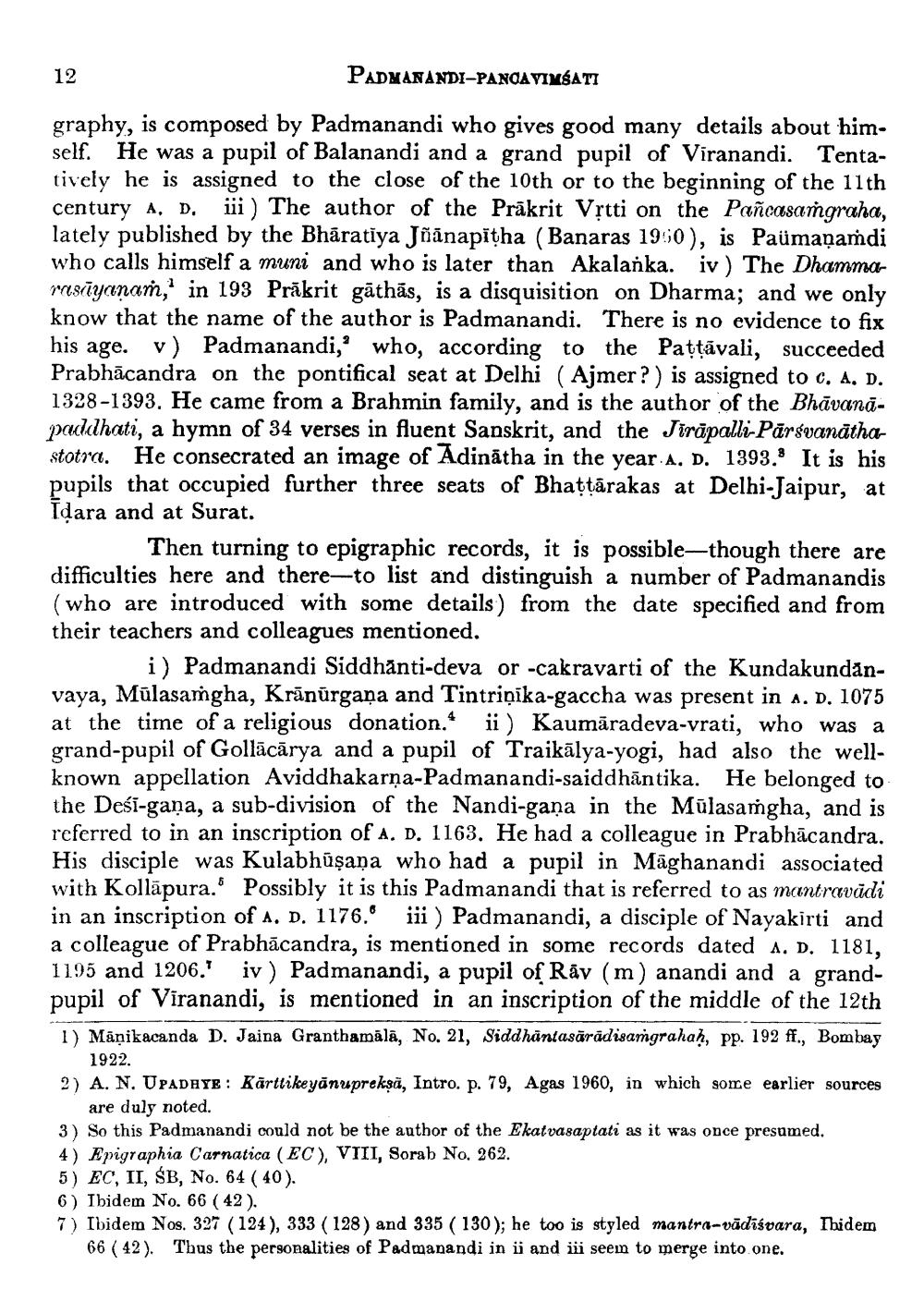________________
12
PADMANANDI-PANOA YIMŠATI
graphy, is composed by Padmanandi who gives good many details about himself. He was a pupil of Balanandi and a grand pupil of Viranandi. Tentatively he is assigned to the close of the 10th or to the beginning of the 11th century A. D. ii) The author of the Prākrit Vrtti on the Pañcasaṁgraha, lately published by the Bhāratiya Jñānapitha (Banaras 1950), is Paumanamdi who calls himself a muni and who is later than Akalanka. iv) The Dhammaresīyanam, in 193 Prākrit gāthās, is a disquisition on Dharma; and we only know that the name of the author is Padmanandi. There is no evidence to fix his age. v) Padmanandi,' who, according to the Pattāvali, succeeded Prabhācandra on the pontifical seat at Delhi (Ajmer?) is assigned to c, A. D. 1328-1393. He came from a Brahmin family, and is the author of the Bhāvanā. paddhati, a hymn of 34 verses in fluent Sanskrit, and the Jirāpalli-Pārsvanātha stotra. He consecrated an image of Adinātha in the year. A. D. 1393. It is his pupils that occupied further three seats of Bhattārakas at Delhi-Jaipur, at Idara and at Surat.
Then turning to epigraphic records, it is possible—though there are difficulties here and there-to list and distinguish a number of Padmanandis (who are introduced with some details) from the date specified and from their teachers and colleagues mentioned.
i) Padmanandi Siddhanti-deva or -cakravarti of the Kundakundanvaya, Mūlasamgha, Krānürgana and Tintriņika-gaccha was present in a. D. 1075 at the time of a religious donation. ii) Kaumāradeva-vrati, who was a grand-pupil of Gollācārya and a pupil of Traikālya-yogi, had also the wellknown appellation Aviddhakarņa-Padmanandi-saiddhāntika. He belonged to the Desi-gana, a sub-division of the Nandi-gana in the Mülasamgha, and is referred to in an inscription of A. D. 1163. He had a colleague in Prabhācandra. His disciple was Kulabhūşapa who had a pupil in Māghanandi associated with Kollapura. Possibly it is this Padmanandi that is referred to as mantravādi in an inscription of A. D. 1176. iii) Padmanandi, a disciple of Nayakirti and a colleague of Prabhācandra, is mentioned in some records dated A. D. 1181, 1195 and 1206. iv ) Padmanandi, a pupil of Rāv (m) anandi and a grandpupil of Viranandi, is mentioned in an inscription of the middle of the 12th 1) Māņikacanda D. Jaina Granthamālā, No. 21, Siddhāntasārādisamgrahaḥ, pp. 192 ff., Bombay
1922. 2) A. N. UPADHYE: Kārttikeyānupreksā, Intro. p. 79, Agas 1960, in which some earlier sources
are duly noted. 3) So this Padmanandi could not be the author of the Ekatvasaptati as it was once presumed. 4) Epigraphia Carnatica (EC), VIII, Sorah No. 262. 5) EC, II, ŚB, No. 64 ( 40). 6) Ibidem No. 66 (42). 7) Ibidem Nos. 327 (124), 333 ( 128 ) and 335 (130); he too is styled mantra-vādīśvara, Ibidem
66 ( 42). Thus the personalities of Padmanandi in i and iii seem to merge into one.




